The best iPhone apps of 2023
The best iPhone apps you can download today, tested and rated
The best music and audio apps for iPhone
Our favorite iPhone apps for making music, listening to podcasts and being a DJ.

Ableton Note
- $5.99/£4.99/AU$9.99
Ableton Note refines aspects of Ableton Live into a streamlined mobile experience. You start with tracks for drums, bass and lead, pre-populated with sounds, and tap out rhythms and notes, committing them when happy. An intuitive interface lets you nudge notes to fix timing. Rinse and repeat and you can remix your track live on a grid.
Beyond the basics, you can delve into additional tracks, sampling, and effects. Completed works can be sent to Ableton Live – although that’s a one-way journey. You can’t bring those compositions back to your phone.
That might sound limiting – as might the lack of live audio tracks – but this app isn’t for full songs. Think of Ableton Note as a sketchpad to work on quick ideas to explore later – or an opinionated entry point into Ableton’s way of working – and you’ll find it a rewarding iPhone component of a musician’s toolkit.
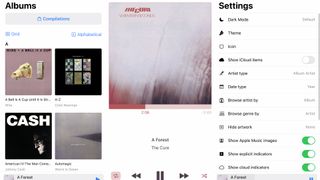
Cs: Music Player
- $2.99/£2.99/AU$4.99
Cs: Music Player is a love letter to the classic era of music players on Apple devices. Although it works with Apple Music (including iCloud libraries), it only cares about - and displays - your personal collection. Accordingly, its tabs provide fast access to artists, albums and playlists, rather than urging you to listen to radio stations or browse latest releases.
The interface is sparse but has plenty of options for how your music is displayed and ordered. The app’s settings enable you to tweak its behavior. You can swipe the mini-player to skip tracks, or long-press it to gain instant access to track details.
For anyone annoyed at Apple constantly marginalizing personal music libraries, Cs is a blessing - a swish, focused player devoid of junk, designed to help you enjoy your music collection all the more.
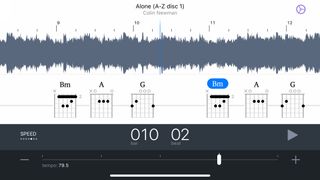
Capo
- Free + $19.99/£18.99/AU$29.99 per year
Capo wants you to learn your favorite songs – without resorting to tabs or sheet music. Instead, Capo analyzes any track you load into it, and automatically attempts to display its chords, tempo and key.
The app doesn’t get everything right, but provides a starting point – useful for obscure titles you can’t find tab for online. Capo’s chords are editable – you can adjust what it presents and add your own; also, songs can be viewed in various ways, including by structure, bar, and as an efficient chords grid.
During playback, the app offers further useful features: you can transpose songs to different keys, slow down the song without affecting its pitch, and create looping regions. Saving edits requires a subscription, but the basics are free to try, so you can see if Capo is your idea of a hit.
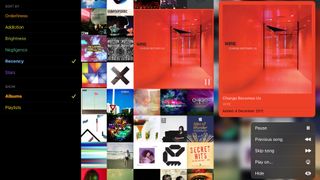
Longplay
- $2.99/£2.99/AU$4.99
Longplay is designed to make you fall in love with playing albums all over again, instead of experiencing music as a series of unconnected tracks. To help you achieve this, the app presents your collection as a grid of covers, which can be ordered in various ways: alphabetically, by rating, on the basis of play count, or - oddly - by artwork brightness. Tap a cover and the album starts playing.
Because Longplay wants you listening to entire albums, it marginalizes other controls. Although it is possible to skip tracks, that functionality only exists in a pop-up. Primary interaction is play/pause on the current album cover. The result is an app that might not be one you use every time you fancy listening to music, but that’s a good bet for rediscovering neglected favorites and the joy of focusing on albums again.
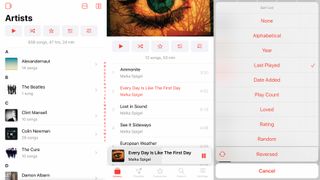
SongOwl
- $1.99/£1.99/AU$3.99
SongOwl reimagines your iPhone’s music collection. Unlike Apple Music, which is geared towards the streaming service, latest releases, and even radio, SongOwl is about getting to your favorites - fast.
The app provides tabs for your library, playlists, favorites, and a search. But also, you can define and save filtered views, for example to group tracks alphabetically by album, or list them by least recently played, to surface songs you’ve not heard in a while.
The app is fast, easy to use, and enables you to list or omit files stored in iCloud. And if you like the idea of an alternate way to view and play your music, but would prefer something more traditional in nature, SongOwl’s creator also offers C’s Classic Music Player, which is like going back in time to Apple’s Music app years ago - but in a good way.
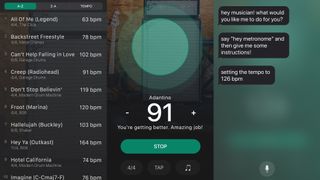
AudioKit Hey Metronome
- $1.99/£1.99/AU$2.99
AudioKit Hey Metronome deals with the thorny problem of resetting your metronome when jamming away on an instrument. That might not sound like a major concern; but when you’re in the zone, you don’t want to be putting down your guitar or violin, messing about with a time-keeper, and then kicking things off again.
With AudioKit Hey Metronome, you get something seemingly imbued with a bit of Siri, in that you can use your voice to have the app adjust the tempo, time signature, and appearance that the metronome uses. All of this works offline.
There are multiple sound-sets, too, if you don’t fancy playing along to bleeps. In fact, Hey Metronome provides a range of canned drum sounds and beats for having a crack at some popular hits; and you can craft your own playlists as well, to ready yourself for that upcoming gig.
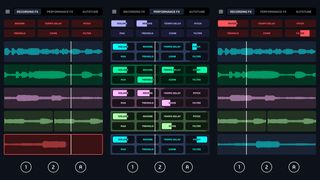
AudioKit L7 – Live Looper
- $19.99/£19.99/AU$30.99
AudioKit L7 – Live Looper brings pro-grade live looping functionality to iPhone in a way that’s easy for anyone to use. Inspired by the Roland Boss RC-505 Loop Station, the app lets you use your device’s mic to gradually build a composition from loops of audio you record live.
The app is designed primarily for use with your voice. Even if you can’t hold a tune, you can beatbox a rhythm, and when you do want to try your hand at bass or melody, autotune and other effects are on hand to help.
For other instruments, the app is less immediate and a touch fiddly, but nonetheless usable when working on layered ideas for guitars. We suspect the cost may be off-putting for the merely curious, but if you’ve ever wanted your iPhone to be a portable looper, this is the app you’ve been waiting for.
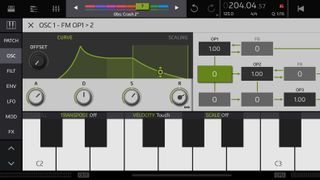
NanoStudio 2
- $19.99/£19.99/AU$30.99
NanoStudio 2 is the follow-up to indie darling NanoStudio, a critically acclaimed iPhone app that let musicians crank out ear-fizzing electronic tunes on an iPhone before GarageBand for iOS was a twinkle in Apple’s eye. However, whereas NanoStudio felt like a silo (albeit an impressive one), NanoStudio 2 is more like a hub.
The app comes with two hugely impressive instruments. Obsidian is a synth with loads of filters and parameters, enabling a wide range of sounds. 300 presets are built in. Slate is a performance pad, designed for samples and drums. But you can also load Audio Units to further expand your audio soundscape.
All these noises are twinned with a full suite of arrangement, sequencing and export functionality. On iPhone, the smaller screen perhaps limits the scope for live play and speedy working, but NanoStudio 2 nevertheless remains a first-rate option for making a chart topper on the go.
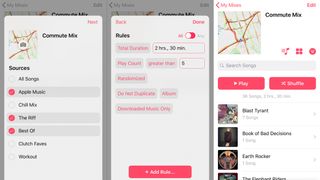
Miximum
- Free + $1.99/£1.99/AU$2.99
Miximum brings to your iPhone a playlist power-user feature from iTunes. Rather than laboriously dragging and dropping tracks from Apple Music, or relying on Apple’s curated lists, you can define collections based on your own criteria – dynamic playlists that update as you adjust their rules.
For example, you could create a playlist based on tracks you’ve flagged as ‘loved’, but that haven’t been played over the past month. Or you could get up to date with your listening by having a playlist based on recently added tracks you’ve not yet heard, and that have been downloaded to your phone for offline use.
Despite the inherent power in this app, Miximum is extremely easy to use. This iPhone app is therefore beneficial to Apple Music users who want more control over their playlists, in a manner that recognizes collections often change over time.

Songbirds
- $1.99/£1.99/AU$2.99
Songbirds is a set of three artistic vignettes that are part meditative aid, part musical instrument. Each of them finds you crafting melodies by directing digital birds across vibrant, minimal scenes.
The best of them is called The Sky. It has you draw pathways akin to constellations, each ‘star’ playing a note when a bird moves over it. With support for up to four simultaneous melodies, you can craft surprisingly intricate sounds, and if you make something you love, tap record to output a video.
The other two options are The Lake, where you control the timing of birds diving into water, and The Flock, in which you use square ‘moons’ to record compositions played out on abstract keyboards. Neither quite matches the intoxicating joy of The Sky, but together, this collection is calming, engaging, and beautiful.
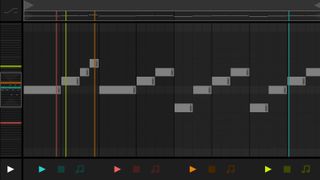
Fugue Machine
- $9.99/£9.99/AU$14.99
Fugue Machine is a tool for making music based on compositional techniques used by Bach. That perhaps sounds dry, but stick with us, because Fugue Machine makes it astonishingly easy to create beautiful audio.
You tap out notes on a piano roll, much like in GarageBand. The twist is that in this app, there’s only ever a single loop, but with up to four playheads moving over it. Each playhead is controlled independently, and this means you can play your loop at different speeds and pitches simultaneously, and in different directions.
The interplay of several variations of a melody quickly becomes hypnotic. For beginners, it’s a great way to start making music. For professionals, it’s also a must – not least given that Fugue Machine ships with comprehensive MIDI, AUv3, Ableton Link, IAA, and Audiobus support.

djay
- Free + $4.99/£4.49/AU$7.49 monthly
djay is a hugely powerful DJ app for iOS. Formerly released in various flavors, it’s now universal and a free download. On install, you get a basic two-deck system with crossfader, looping, and some effects. Go pro, though, and a world of high-end DJ power opens up.
At that point, you can run up to four decks, and dabble in video mixing. You get over 1GB of samples, loops, and visuals to trigger. There’s a ton of integration with a range of hardware solutions. Automix is available too, for when you can’t be bothered doing the DJ work yourself.
On iPhone, it’s naturally a bit fiddly compared to the iPad’s relative acres – but it’s also a very portable way to always have the app on you for experimenting with – and useful for hooking up to physical controllers.

SquareSynth 2
- $4.99/£4.99/AU$7.99
SquareSynth 2 seems to have two reasons to exist. The first is to make you grin on selecting a preset, tapping a key, and having some retro audio blaze forth from your iPhone. The built-in sounds are reminiscent of noise you’d once have heard blasting from a Commodore 64 or NES; this in itself is all rather good fun.
But for musicians, this is a full-fledged synth. You can delve into each sound and muck about with its parameters – the results of which can be ear-thumpingly terrific. AudioUnit support also means this isn’t an isolated box – the entire thing can essentially be squirted into GarageBand. Only the slightly awkward interface on iPhone when editing lets it down a touch – but the great sounds more than make up for that.

Samplebot
- $3.99/£3.99/AU$5.99
Samplebot is a colorful grid of buttons that you use to capture sounds. Press a pad, make a noise, and it’s then played by tapping the pad again. Fun stuff – but it turns out Samplebot has more layers than an onion.
Recorded sounds can be trimmed, and arranged in a sequencer. Pre-defined drum patterns are included, but you can also tap out your own. Beyond that, you can import audio from cloud services, Music, Files, or the clipboard, and manage sounds in-app. Tracks can be exported, and Samplebot can even be synced to other music apps.
In short, then, Samplebot is ideal for anyone wanting to make some noise, whether you fancy recording and playing back pots and pans being whacked, or creating entire songs.

GarageBand
- Free
GarageBand is a music creation app and recording studio. Ambitiously, it aims to suit newcomers and pro musicians alike – and it succeeds.
For newcomers, there are smart instruments that automate chords and riffs, and a grid pad for triggering samples and loops. Gain in confidence and you can plug in a guitar and use GarageBand’s excellent range of amps, experiment with the timeline, and create drum patterns in the Beat Sequencer.
For pros, though, this app connects to other apps via Inter-App Audio and Audiobus, can ‘import’ entire third-party apps as Audio Units, and enables you to record, arrange and mix up to 32 tracks.
The app’s a stunning achievement, and we suspect many long-time musicians can’t believe such a thing exists on a phone.

Brian Eno: Reflection
- $30.99/£29.99/AU$47.99
In a sense, featuring Brian Eno : Reflection in this round-up is a bit weird. Unlike other collaborations between musician Eno and software designer/musician Peter Chilvers, Reflection is broadly devoid of interaction. Instead, it effectively just plays Eno’s ambient Reflection album, but with some clever twists.
Unlike the standard album, which is the same every time you listen, the audio here has phrases and patterns within that continually interact in different ways, and subtly change as the day progresses, creating an endlessly changing version of the music. Likewise, the painterly visual on the screen slowly morphs before your eyes.
It’s pricey, but ultimately gives you endless Eno and is an intoxicating experience for anyone that likes their ambient fare. The man himself describes the app like sitting by a river: it’s the same river, but always changing. By contrast, the standard Reflections album initially sounds similar, but it’s a recording frozen in time, never changing.
Current page: The best music and audio apps for iPhone
Prev Page The best kids' apps for iPhone Next Page The best office and writing apps for iPhoneGet daily insight, inspiration and deals in your inbox
Get the hottest deals available in your inbox plus news, reviews, opinion, analysis and more from the TechRadar team.
